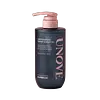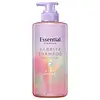What's inside
What's inside
 Key Ingredients
Key Ingredients

 Benefits
Benefits

 Concerns
Concerns

 Ingredients Side-by-side
Ingredients Side-by-side

Water
Skin ConditioningSodium Laureth Sulfate
CleansingAmmonium Lauryl Sulfate
CleansingCocamidopropyl Betaine
CleansingDipropylene Glycol
HumectantParfum
MaskingPPG-3 Myristyl Ether
EmollientSodium Benzoate
MaskingPolyquaternium-10
Sodium Chloride
MaskingCaprylyl Glycol
EmollientCitric Acid
BufferingHydroxypropyl Guar Hydroxypropyltrimonium Chloride
Hexyl Cinnamal
PerfumingPhenoxyethanol
PreservativePentasodium Pentetate
Sodium Carbonate
BufferingLimonene
PerfumingCitronellol
PerfumingGeraniol
PerfumingHydrolyzed Milk Protein
Skin ConditioningHydrolyzed Collagen
EmollientButylene Glycol
Humectant1,2-Hexanediol
Skin ConditioningHydrolyzed Silk
HumectantMentha Piperita Leaf Extract
Skin ConditioningChamomilla Recutita Flower Extract
MaskingMonarda Didyma Leaf Extract
Skin ConditioningRosmarinus Officinalis Leaf Extract
AntimicrobialFreesia Refracta Extract
Skin ConditioningLavandula Angustifolia Extract
Skin ConditioningHydrolyzed Keratin
HumectantEthyl Hexanediol
SolventSilk Amino Acids
HumectantEthylhexylglycerin
Skin ConditioningCamellia Japonica Seed Oil
EmollientOlea Europaea Fruit Oil
MaskingArgania Spinosa Kernel Oil
EmollientMacadamia Integrifolia Seed Oil
Skin ConditioningHelianthus Annuus Seed Oil
EmollientHydrolyzed Corn Protein
Skin ConditioningHydrolyzed Soy Protein
HumectantHydrolyzed Wheat Protein
Skin ConditioningLeucine
Skin ConditioningTaurine
BufferingIsoleucine
Skin ConditioningValine
MaskingAspartic Acid
MaskingOrnithine
Skin ConditioningGlutamic Acid
HumectantGlycine
BufferingGlutamine
Skin ConditioningCystine
MaskingMethionine
Skin ConditioningTyrosine
MaskingLysine
Skin ConditioningAlanine
MaskingPhenylalanine
MaskingSerine
MaskingTryptophan
MaskingThreonine
Arginine
MaskingHistidine
HumectantAsparagine
MaskingProline
Skin ConditioningWater, Sodium Laureth Sulfate, Ammonium Lauryl Sulfate, Cocamidopropyl Betaine, Dipropylene Glycol, Parfum, PPG-3 Myristyl Ether, Sodium Benzoate, Polyquaternium-10, Sodium Chloride, Caprylyl Glycol, Citric Acid, Hydroxypropyl Guar Hydroxypropyltrimonium Chloride, Hexyl Cinnamal, Phenoxyethanol, Pentasodium Pentetate, Sodium Carbonate, Limonene, Citronellol, Geraniol, Hydrolyzed Milk Protein, Hydrolyzed Collagen, Butylene Glycol, 1,2-Hexanediol, Hydrolyzed Silk, Mentha Piperita Leaf Extract, Chamomilla Recutita Flower Extract, Monarda Didyma Leaf Extract, Rosmarinus Officinalis Leaf Extract, Freesia Refracta Extract, Lavandula Angustifolia Extract, Hydrolyzed Keratin, Ethyl Hexanediol, Silk Amino Acids, Ethylhexylglycerin, Camellia Japonica Seed Oil, Olea Europaea Fruit Oil, Argania Spinosa Kernel Oil, Macadamia Integrifolia Seed Oil, Helianthus Annuus Seed Oil, Hydrolyzed Corn Protein, Hydrolyzed Soy Protein, Hydrolyzed Wheat Protein, Leucine, Taurine, Isoleucine, Valine, Aspartic Acid, Ornithine, Glutamic Acid, Glycine, Glutamine, Cystine, Methionine, Tyrosine, Lysine, Alanine, Phenylalanine, Serine, Tryptophan, Threonine, Arginine, Histidine, Asparagine, Proline
Water
Skin ConditioningSodium Taurine Cocoyl Methyltaurate
CleansingSodium Lauroyl Methylalanine
Cocamide Methyl Mea
Sodium Cocoamphoacetate
CleansingLauramidopropyl Betaine
CleansingLaureth-11 Carboxylic Acid
CleansingLaureth-23
CleansingSodium Lauroyl Hydrolyzed Silk
Skin ConditioningLanolin Acid
CleansingHydrolyzed Collagen
EmollientSqualane
EmollientHydrogenated Shea Oil
EmollientSodium Hyaluronate
HumectantRoyal Jelly Extract
Skin ConditioningArgania Spinosa Kernel Oil
EmollientCitric Acid
BufferingSuccinic Acid
BufferingLauroyl Sarcosine
CleansingLactic Acid
BufferingPEG-6 Sorbitan Oleate
EmulsifyingPPG-2 Cocamide
PEG-160 Sorbitan Triisostearate
CleansingEthylhexylglycerin
Skin ConditioningPPG-3 Caprylyl Ether
SolventPolyquaternium-10
Polyquaternium-52
Dipropylene Glycol
HumectantStearoxypropyl Dimethylamine
Stearyl Alcohol
EmollientLaureth-16
EmulsifyingPhenoxyethanol
PreservativeBenzyl Alcohol
PerfumingAlcohol Denat.
AntimicrobialSodium Hydroxide
BufferingSodium Benzoate
MaskingCaramel
Cosmetic ColorantParfum
MaskingWater, Sodium Taurine Cocoyl Methyltaurate, Sodium Lauroyl Methylalanine, Cocamide Methyl Mea, Sodium Cocoamphoacetate, Lauramidopropyl Betaine, Laureth-11 Carboxylic Acid, Laureth-23, Sodium Lauroyl Hydrolyzed Silk, Lanolin Acid, Hydrolyzed Collagen, Squalane, Hydrogenated Shea Oil, Sodium Hyaluronate, Royal Jelly Extract, Argania Spinosa Kernel Oil, Citric Acid, Succinic Acid, Lauroyl Sarcosine, Lactic Acid, PEG-6 Sorbitan Oleate, PPG-2 Cocamide, PEG-160 Sorbitan Triisostearate, Ethylhexylglycerin, PPG-3 Caprylyl Ether, Polyquaternium-10, Polyquaternium-52, Dipropylene Glycol, Stearoxypropyl Dimethylamine, Stearyl Alcohol, Laureth-16, Phenoxyethanol, Benzyl Alcohol, Alcohol Denat., Sodium Hydroxide, Sodium Benzoate, Caramel, Parfum
Ingredients Explained
These ingredients are found in both products.
Ingredients higher up in an ingredient list are typically present in a larger amount.
You may know this ingredient as argan oil. Argan Oil has antioxidant, hydrating, and soothing properties.
Studies have shown argan oil can help fight again radical damage from the sun. This makes it effective at preventing hyperpigmentation.
Large amounts of vitamin E found in argan oil helps the skin retain water. Argan oil also contains fatty acids such as linoleic acid, oleic acid, and palmitic acid. It is also a good source of lipids.
Another benefit of argan oil is skin-soothing. It can help reduce inflammation-related skin symptoms.
Argan Oil is effective at regulating sebum production in pores. This can make it effective at treating hormonal acne.
Traditionally, argan oil was used for its antibacterial and antifungal properties. However, argan oil contains fatty acids that may make it not fungal-acne safe.
Argan Trees are native to Morocco.
Learn more about Argania Spinosa Kernel OilCitric Acid is an alpha hydroxy acid (AHA) naturally found in citrus fruits like oranges, lemons, and limes.
Like other AHAs, citric acid can exfoliate skin by breaking down the bonds that hold dead skin cells together. This helps reveal smoother and brighter skin underneath.
However, this exfoliating effect only happens at high concentrations (20%) which can be hard to find in cosmetic products.
Due to this, citric acid is usually included in small amounts as a pH adjuster. This helps keep products slightly more acidic and compatible with skin's natural pH.
In skincare formulas, citric acid can:
While it can provide some skin benefits, research shows lactic acid and glycolic acid are generally more effective and less irritating exfoliants.
Most citric acid used in skincare today is made by fermenting sugars (usually from molasses). This synthetic version is identical to the natural citrus form but easier to stabilize and use in formulations.
Read more about some other popular AHA's here:
Learn more about Citric AcidDipropylene Glycol is a synthetically created humectant, stabilizer, and solvent.
This ingredient helps:
Dipropylene glycol is technically an alcohol, but it belongs to the glycol family (often considered part of the ‘good’ alcohols). This means it is hydrating and gentle on skin unlike drying solvent alcohols like denatured alcohol.
As a masking agent, Dipropylene Glycol can be used to cover the smell of other ingredients. However, it does not have a scent.
Studies show Dipropylene Glycol is considered safe to use in skincare.
Learn more about Dipropylene GlycolEthylhexylglycerin (we can't pronounce this either) is commonly used as a preservative and skin softener. It is derived from glyceryl.
You might see Ethylhexylglycerin often paired with other preservatives such as phenoxyethanol. Ethylhexylglycerin has been found to increase the effectiveness of these other preservatives.
Hydrolyzed collagen has a misleading name because it is actually a mixture of various proteins/peptides. This ingredient has skin hydrating properties.
Collagen is the most abundant type of structural protein found in your body. In your skin, it is responsible for keeping it firm and youthful.
Hydrolyzed Collagen is created by breaking up proteins into smaller peptide bonds. These peptides act as humectants and emollients.
Humectants are great at holding onto water, keeping skin hydrated. Emollients create a thin barrier on the skin to prevent moisture from escaping.
There is ongoing debate about whether hydrolyzed collagen works because it increases skin hydration. Skin hydration is also linked to elasticity and the appearance of wrinkles.
Collagen or peptide ingredients can be used in the morning or night. They will not increase sun sensitivity, but you should always wear sunscreen during the day.
According to a manufacturer, this ingredient is a great hair conditioner as well.
This ingredient can be extracted from different sources, including:
Vegan collagen is derived from yeast, bacteria, or plant sources. Vegan collagen would go by a different INCI name, such as hydrolyzed soy protein.
The results are varied.
A study from 2021 found hydrolyzed collagen increased elasticity and improved wrinkles in 1,125 participants between age 20 and 70. Another study found increased skin thickness in participants between the ages of 45 to 59.
However, It is difficult to prove that oral collagen will end up working on your skin. Many of the studies using hydrolyzed collagen also add several vitamins and nutrients into the test mixture as well.
Further studies are needed at this time.
Learn more about Hydrolyzed CollagenParfum is a catch-all term for an ingredient or more that is used to give a scent to products.
Also called "fragrance", this ingredient can be a blend of hundreds of chemicals or plant oils. This means every product with "fragrance" or "parfum" in the ingredients list is a different mixture.
For instance, Habanolide is a proprietary trade name for a specific aroma chemical. When used as a fragrance ingredient in cosmetics, most aroma chemicals fall under the broad labeling category of “FRAGRANCE” or “PARFUM” according to EU and US regulations.
The term 'parfum' or 'fragrance' is not regulated in many countries. In many cases, it is up to the brand to define this term.
For instance, many brands choose to label themselves as "fragrance-free" because they are not using synthetic fragrances. However, their products may still contain ingredients such as essential oils that are considered a fragrance by INCI standards.
One example is Calendula flower extract. Calendula is an essential oil that still imparts a scent or 'fragrance'.
Depending on the blend, the ingredients in the mixture can cause allergies and sensitivities on the skin. Some ingredients that are known EU allergens include linalool and citronellol.
Parfum can also be used to mask or cover an unpleasant scent.
The bottom line is: not all fragrances/parfum/ingredients are created equally. If you are worried about fragrances, we recommend taking a closer look at an ingredient. And of course, we always recommend speaking with a professional.
Learn more about ParfumPhenoxyethanol is a preservative that has germicide, antimicrobial, and aromatic properties. Studies show that phenoxyethanol can prevent microbial growth. By itself, it has a scent that is similar to that of a rose.
It's often used in formulations along with Caprylyl Glycol to preserve the shelf life of products.
Polyquaternium-10 is an ammonium salt of hydroxyethylcellulose. It is a white and granular powder used as a film-former and anti-static agent.
This ingredient is commonly found in hair conditioning products. According to a manufacturer, its positive charge makes it great for absorbing hair proteins. The manufacturer also states this ingredient helps with curl retention.
For haircare friends: this ingredient is not a silicone.
Learn more about Polyquaternium-10Sodium Benzoate is a preservative. It's used in both cosmetic and food products to inhibit the growth of mold and bacteria. It is typically produced synthetically.
Both the US FDA and EU Health Committee have approved the use of sodium benzoate. In the US, levels of 0.1% (of the total product) are allowed.
Sodium benzoate works as a preservative by inhibiting the growth of bacteria inside of cells. It prevents the cell from fermenting a type of sugar using an enzyme called phosphofructokinase.
It is the salt of benzoic acid. Foods containing sodium benzoate include soda, salad dressings, condiments, fruit juices, wines, and snack foods.
Studies for using ascorbic acid and sodium benzoate in cosmetics are lacking, especially in skincare routines with multiple steps.
We always recommend speaking with a professional, such as a dermatologist, if you have any concerns.
Learn more about Sodium BenzoateWater. It's the most common cosmetic ingredient of all. You'll usually see it at the top of ingredient lists, meaning that it makes up the largest part of the product.
So why is it so popular? Water most often acts as a solvent - this means that it helps dissolve other ingredients into the formulation.
You'll also recognize water as that liquid we all need to stay alive. If you see this, drink a glass of water. Stay hydrated!
Learn more about Water